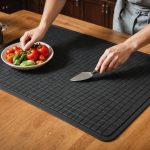Overview of Effortless Meal Planning
Meal planning is a cornerstone for achieving a healthy lifestyle, offering numerous benefits like improving dietary success and enhancing kitchen efficiency. By organising meals ahead of time, individuals can ensure balanced nutrition whilst saving both time and effort throughout the week. Meal planning basics revolve around understanding one’s dietary goals and habits, which forms the foundation for any effective plan.
A streamlined approach in the kitchen can further boost time management, leading to more time to enjoy meals rather than preparing them. This involves arranging kitchen layouts for maximized efficiency and using tools and techniques to quicken meal preparation. Whether aiming for keto, vegan, or another dietary type, different meal strategies must cater specifically to the nutritional and lifestyle needs of that diet.
Also to discover : Revamp Your Kitchen Layout: Smart Space Management to Curb Overeating
Ultimately, mastering these meal planning basics empowers individuals to meet personal nutrition targets with ease and grace, fully embracing the practicality and benefits that come with strategic organisation. It’s about crafting a routine that aligns with one’s lifestyle, saving time and promoting a healthier relationship with food. Streamlined kitchen practices and well-structured planning pave the path to more enjoyable and successful dietary experiences.
Step-by-Step Meal Planning Strategies
Effective meal planning strategies start with identifying your nutrition goals and preferences. Understanding these helps tailor your meal plans to support your dietary aspirations—be it weight loss, muscle building, or simply eating healthier. Knowing what you want to achieve guides all other planning aspects.
In parallel : Revamp Your Diet: How a Kitchen Chalkboard Wall Can Streamline Your Meal Planning and Achieve Dietary Goals
Identifying Dietary Goals and Preferences
Begin by assessing your current eating habits. Determine which areas require improvements to meet your nutritional needs. Are you aiming to consume more plant-based foods, incorporate more protein, or reduce processed sugar? These insights will shape your meal planning.
Creating a Weekly Meal Plan Template
After establishing goals, create a weekly meal plan template. This template should outline meals for each day, ensuring a balanced intake. Flexibility is key—aim to include a variety of flavours and nutrients to avoid monotony.
Incorporate a mixture of familiar recipes and new ones that align with your goals. When selecting meals, balance simplicity and excitement. Spontaneity can keep meals enjoyable without complicating the process.
Preparing a Flexible Cooking Schedule
Schedule realistic meal prep days. Perhaps set aside weekend mornings for extensive cooking, and use quieter weekdays for simpler dishes. Always account for life’s unpredictability by building in room for adjustments, keeping meal prep adaptable around your lifestyle.
Recipe Suggestions for Streamlined Cooking
Crafting quick recipes is essential for maintaining a healthy lifestyle without compromising on time. For those following specific diets such as keto or vegan, it’s vital to have a repertoire of time-efficient recipes.
Time-efficient Recipes for Different Diets
For a keto diet, dishes like avocado and egg salad or zucchini noodles with pesto are perfect due to their low-carb content, providing satiety without excess prep time. Vegans can enjoy chickpea stir-fries or lentil soups; these not only support dietary preferences but are also quick to prepare.
One-Pot Meals and Batch Cooking Techniques
Opt for one-pot meals like curry or risotto that consolidate cooking time and minimize washing up. Batch cooking enhances kitchen efficiency further. Prepare large quantities of basics like grains or legumes that can be used throughout the week.
Seasonal Recipes Using Fresh Ingredients
Incorporating seasonal recipes offers both freshness and cost-effectiveness. A spring vegetable tray bake or a hearty winter stew can capitalize on what’s available at the time, ensuring meals are vibrant and nutritious. By making the most of what’s in season, you ensure both flavour and cost-efficiency.
Crafting a Comprehensive Shopping List
A well-structured grocery list is paramount for ensuring efficient and budget-friendly meal planning. Tailor your list to accommodate various diet types, considering the essentials for each. For keto diets, focus on low-carb vegetables, healthy fats like avocado, and lean meats. Vegans might prioritize plant-based proteins such as beans and legumes, along with a variety of fruits and vegetables.
Tips for Efficient Grocery Shopping
Begin by organising the list based on store layout to save time. Group items by category such as produce, dairy, and pantry staples. Implement bulk buying strategies for non-perishables like grains and canned goods, which can significantly cut costs. Shopping in this manner allows for flexibility and ease in preparation.
Seasonal Shopping: Maximizing Freshness and Savings
Opt for seasonal produce to ensure freshness and cost-effectiveness. Familiarize yourself with local farmers’ markets, which often offer fresh, seasonal items at lower prices. When planning, incorporate local produce to enrich meals with vibrant flavours without breaking the bank. Adapting your list to seasonality not only enhances taste but supports sustainable practices, benefiting your health and wallet.
Kitchen Organization Techniques
A well-organized kitchen is essential for enhancing both space optimization and kitchen efficiency. By arranging your kitchen wisely, you can significantly reduce meal preparation time.
Organizing Pantry and Fridge
Start by organizing your pantry and fridge. Categorize items to ensure everything is visible and easily accessible. Label containers and sort similar items together, such as grains or spices, for quick retrieval. Prioritize using transparent storage options to instantly identify contents and monitor quantities.
Utilizing Kitchen Tools
Efficiency tools like cutting boards with drawers or spice racks can be game-changers. These tools minimize prep time by keeping essentials within arm’s reach, allowing you to focus on cooking rather than searching for ingredients.
Incorporating Storage Solutions
Maximize storage solutions by using wall-mounted shelves, hooks, or pull-out cabinets for pots and pans. This not only declutters countertops but also makes better use of available space. Ensure every tool and ingredient has a designated spot, reducing chaos and promoting a streamlined workflow. Adopting these techniques leads to better time management, enabling you to focus more on enjoying meals and less on organization tasks.
Time-Saving Hacks for Meal Prep
Integrating smart meal prep hacks can remarkably boost time management, making daily cooking a breeze. Firstly, invest time in prepping ingredients ahead of schedule. By washing, chopping, and storing essentials such as vegetables and proteins in airtight containers, you shave off precious minutes during weekday meals.
Creative use of leftovers is another essential strategy. Transform last night’s dinner into a delightful new dish, preventing food waste while saving time. For instance, leftover roast chicken can easily become a scrumptious chicken salad or filling for wraps.
Incorporate kitchen gadgets effectively to streamline cooking. Devices like slow cookers and air fryers require minimal attention, allowing multitasking. Batch cooking in these tools ensures a bounty of meals with less effort, freeing up time for other activities.
Finally, adopt batch cooking techniques for future consumption. Prepare large volumes of versatile dishes like soups or stews to freeze in portions. Such bulk cooking sessions replace cooking on busy days, embodying efficient meal prep practices. Embracing these hacks grants more time for enjoying meals rather than labouring over their preparation.
Maintaining Flexibility in Meal Planning
In adapting to life’s unpredictabilities, maintaining flexibility in meal planning is key. Adaptability allows you to pivot and meet dietary needs without stress, even amid unexpected schedule changes. Such meal prep flexibility ensures you’re ready for anything, be it a surprise guest or an unplanned late meeting.
Strategies for Handling Unforeseen Schedule Changes
Embrace versatile recipes that can be altered quickly using available ingredients. Incorporate freeze-able meals or adaptable stir-fries that cater to varied tastes and can still maintain dietary success.
Adjusting Meal Plans Based on Cravings or Seasonal Changes
Use seasonal produce to add variety and freshness—this not only caters to spontaneous cravings but also ensures nutritional balance. Think of a warming soup in winter or a fresh salad in summer, easily adjustable to accommodate dietary changes.
Keeping Options Open for Last-Minute Meals
Stock essential pantry items like grains, legumes, and selection of herbs. This establishes a foundation for creating quick and diverse dishes without a detailed plan. Having these staples can morph into multiple meal ideas, meeting diverse cravings or dietary shifts effortlessly.
Visual Aids and Templates for Meal Planning
Integrating meal planning tools into your routine can significantly enhance organization and efficiency. Printable meal planning templates are excellent for those who appreciate a tangible guide. These templates streamline weekly meal layouts by providing a visual structure for a balanced diet. Choose from various styles to suit your needs, whether you prefer templates with spaces for notes or more minimal layouts.
Charts for dietary constraints can be invaluable for managing portion sizes. They offer visual guidance by outlining nutritional requirements. Use them to ensure your meals align with specific dietary goals, such as maintaining a keto or vegan diet, without compromising nutritional balance.
Digital solutions, including top-rated meal planning apps, take meal organization to the next level. These apps offer user-friendly interfaces to plan meals, track nutritional intake, and adapt plans on the go. Visual aids within these applications, like progress graphs and interactive menus, enhance understanding of dietary habits. This integration of technology supports visual organization by offering instant modifications and reminders, making meal planning more adaptable and less time-consuming, helping maintain consistency in dietary success.



